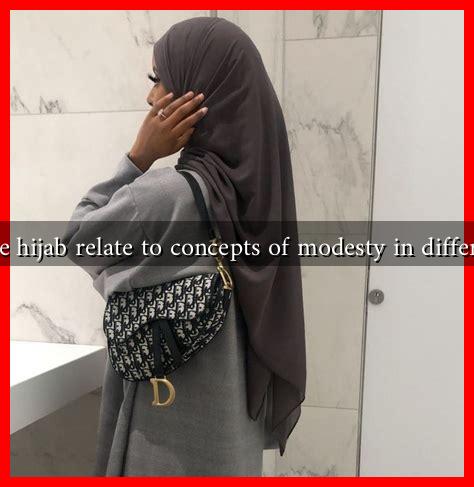-
Table of Contents
- How Does the Hijab Relate to Concepts of Modesty in Different Cultures?
- The Hijab: A Symbol of Modesty in Islam
- Modesty Across Cultures: A Broader Perspective
- Western Perspectives on Modesty
- Modesty in Other Cultures
- Case Studies: The Hijab in Different Contexts
- Statistics and Trends
- Conclusion: Embracing Diversity in Modesty
How Does the Hijab Relate to Concepts of Modesty in Different Cultures?
The hijab, a traditional headscarf worn by many Muslim women, is often associated with the concept of modesty. However, the interpretation and significance of modesty vary widely across different cultures and religions. This article explores how the hijab relates to modesty, examining its cultural implications, historical context, and the diverse perspectives surrounding it.
The Hijab: A Symbol of Modesty in Islam
In Islamic culture, the hijab is more than just a piece of clothing; it is a symbol of faith and identity. The Quran emphasizes modesty, instructing both men and women to dress in a way that reflects their dignity and respect for themselves and others. The hijab serves as a physical manifestation of these teachings.
- Religious Significance: For many Muslim women, wearing the hijab is an act of obedience to God. It is seen as a way to express their devotion and commitment to their faith.
- Empowerment: Contrary to some perceptions, many women view the hijab as a source of empowerment. It allows them to define their identity on their own terms, free from societal pressures regarding beauty standards.
Modesty Across Cultures: A Broader Perspective
While the hijab is often associated with Islamic modesty, the concept of modesty is not exclusive to one religion or culture. Various societies have their interpretations of modesty, which can be reflected in clothing, behavior, and social interactions.
Western Perspectives on Modesty
In Western cultures, modesty has evolved over time, often influenced by changing fashion trends and social norms. Historically, modesty was associated with conservative dress, particularly for women. However, contemporary views on modesty can be more fluid.
- Fashion Choices: In many Western societies, modesty can be expressed through fashion choices that prioritize comfort and personal style over revealing clothing.
- Body Positivity Movement: The rise of the body positivity movement has encouraged individuals to embrace their bodies, regardless of size or shape, leading to a redefinition of modesty that emphasizes self-acceptance.
Modesty in Other Cultures
Many cultures around the world have their own interpretations of modesty, often reflected in traditional attire:
- Indian Culture: In India, the saree is a traditional garment that embodies modesty while allowing for personal expression through various styles and draping techniques.
- Japanese Culture: The kimono is a symbol of modesty in Japan, representing grace and elegance while covering the body in a respectful manner.
Case Studies: The Hijab in Different Contexts
The hijab’s significance can vary greatly depending on the cultural and social context. Here are a few case studies that illustrate this diversity:
- Turkey: In Turkey, the hijab has been a subject of political debate. While some women wear it as a personal choice, others face restrictions in public institutions, reflecting the tension between secularism and religious expression.
- France: France’s ban on religious symbols in schools, including the hijab, has sparked discussions about secularism and individual rights. This has led to a complex dialogue about the intersection of modesty, identity, and freedom.
Statistics and Trends
According to a 2017 Pew Research Center study, approximately 62% of Muslim women worldwide wear the hijab, with variations based on cultural and regional factors. This statistic highlights the diversity of practices and beliefs surrounding modesty within the Muslim community.
Conclusion: Embracing Diversity in Modesty
The hijab serves as a powerful symbol of modesty within Islamic culture, but its significance extends beyond religious boundaries. Modesty is a multifaceted concept that varies across cultures, influenced by historical, social, and personal factors. Understanding these diverse perspectives fosters a greater appreciation for the choices individuals make regarding their attire and identity.
As societies continue to evolve, the dialogue surrounding modesty and the hijab will remain relevant. By embracing this diversity, we can promote a more inclusive understanding of modesty that respects individual choices and cultural expressions.
For further reading on the topic, you can explore resources from the Pew Research Center and other academic studies that delve into the cultural significance of modesty across different societies.


